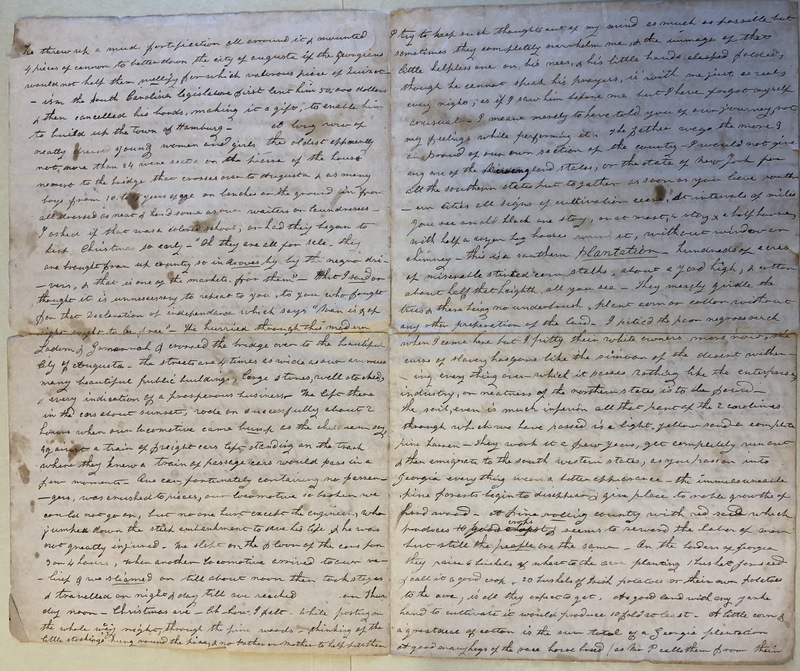"Letter Describing the Antebellum South"
Lucretia writes a letter addressed to her father about her journey through the states of the Antebellum South. This diary entry was most likely recorded around Christmas time, before the Civil War took place. Throughout the letter, she takes notice of the architecture, weather, topography, and the people of her travels. The details Lucretia includes are critical in developing the picture of her location, which revolves around the states involved in the redistribution of the usage of the Savannah River. One can assume Lucretia originates from the North due to the fact that she describes the soil of the southern states as “inferior.” Lucretia also comments on how she looks forward to returning home by stating, “my heart, my spirit are there, welcome will the day be, when I turn my steps homeward again.” Within her journal entries, Lucretia records her reactions to what she encounters. Lucretia refers to slavery as a “curse,” for example, implying how she thinks that the institution of slavery produces more harm than good. She makes an impactful statement when she says, “I pitied the poor negroes much when I came here, but I pity their white owners more now" (Lucretia, "Letter Describing the Antebellum South"). It is interesting to see the different impressions slavery had on individuals in the past.
In relation to what was going on during the time period of the letter, Savannah was experiencing agriculture and societal changes. The Antebellum Period is known for the rapid growth various industries experienced, several of which include transportation means, printing processes, and immigration patterns. Along with the increase in cotton manufacturing, the number of slaves also increased. The industrial growth influenced the shift towards productivity, and Savannah was such a place of development (Mazzei, “Antebellum Industrial Growth”). “After independence was secured [from the British], Savannah flourished” (“History of Savannah”) because of its resourceful soil and location. Slaves were frequently traded through Savannah’s ports, and slavery was then legalized in Georgia as a product of the rise in the demand for plantation workers. Many magnificent buildings were constructed that showcased wealth and prosperity of the city (“History of Savannah”). In contrast to the blossoming success of the city, Lucretia provides her perspective in her journal that acts as a critique to Savannah’s illustrious growth. Her credible letter illustrates an outside approach to recording what Savannah was experiencing before the Civil War.
Works Cited
“History of Savannah.” 2018. https://www.visitsavannah.com/article/history-savannah
Lucretia. “Letter Describing the Antebellum South.” Special Collections Hargrett Manuscripts, 1850’s.
Mazzei, Michael. “Antebellum Industrial Growth.” Salem Press Encyclopedia, 2014. EBSCOhost, proxy-remote.galib.uga.edu/login?url=http://search.ebscohost.com/login.aspx?direct=true&db=ers&AN=98402025&site=eds-live

